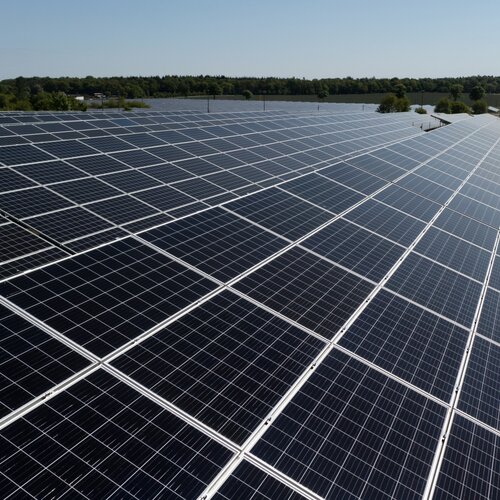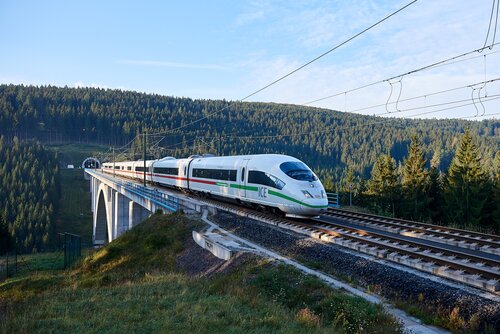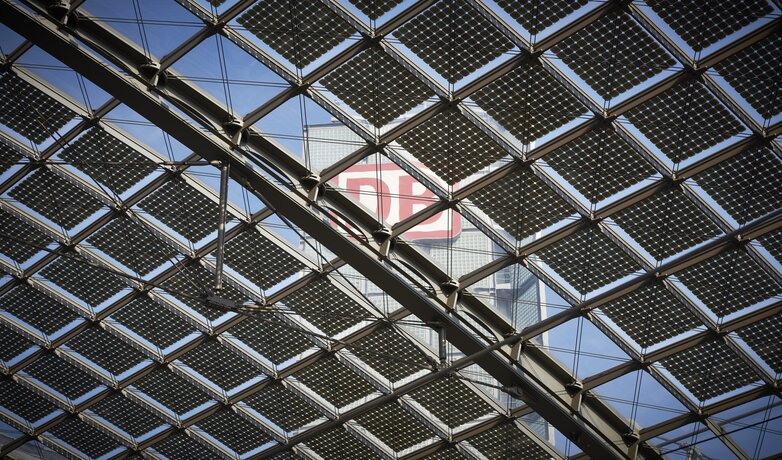Deutsche Bahn reports transparently on the progress it is making in its green transformation and in the social responsibility of the Group. DB also relies on sustainability indicators to strengthen its stakeholders' trust in the Group. Deutsche Bahn has its sustainability work regularly assessed by neutral ESG rating agencies and undergoes objective comparison in international rankings. The company also publishes further information on its sustainability performance in its annual Integrated Report, which is certified by an independent audit.
Climate protection
Deutsche Bahn will be climate neutral by 2040 in accordance with the Net-Zero Standard of the Science Based Targets initiative (SBTi), following a 1.5-degree compliant reduction pathway.
DB traction current mix (preview) – in %
| 2024 | 2023 | |
|---|---|---|
| Rail network operations | 4.684 | 4.966 |
| Passenger Stations | 2.336 | 2.333 |
| Maintenance of rolling stock (facilities) | 2.653 | 2.721 |
| Other | 2.898 | 3.227 |
| Total | 12.570 | 13.248 |
Individual values are rounded and may therefore not sum up exactly.
- Since 2018, all passengers on DB's long-distance electric trains have been traveling on services powered by 100 % green energy.
- In Baden-Württemberg and Schleswig-Holstein, too, regional and local transport passengers travel using 100 % green electricity, provided that rail transport is electrified.
- Since early 2025, all stations, maintenance facilities, office buildings, and facilities of Deutsche Bahn in Germany supplied by DB Energie have been powered by 100 % green electricity. This also includes signal boxes, switch heating systems, and track field lighting.
Resource protection
In order to reduce emissions from increasing construction activity on the rail network, Deutsche Bahn intends to make greater use of low-emission building materials and other materials in the coming years. These are characterized by innovative, resource-saving production processes and the use of recycled materials. In this way, DB is contributing to its net-zero target and also laying the foundation for establishing a circular economy within the Group.
| 2024 | 2023 | 2022 | |
|---|---|---|---|
| Rail steel (thousand t) | 247,1 | 280,4 | 259,0 |
| recycling share (in %) | 25,6 | 24,9 | - |
| Track ballast (thousand t) | 3.236 | 3.880 | 3.471 |
| recycling share (in %) | 11,1 | 12,0 | 11,4 |
| Concrete ties (thousand) | 3.053 | 3.475 | 2.089 |
| recycling share (in %) | 8,5 | 8,7 | 13,3 |
Period 1.10. to 30.9.; data collection process for recycled share of rail steel established in 2023.
- DB's ICE trains have a service life of at least 30 years. To ensure they reach this age, they are redesigned after about half their service life, saving up to 80 % of material costs compared to buying new ones.
- As well as saving time, 3D printing also conserves valuable raw materials. DB has already printed over 150,000 parts and replacement parts in more than 700 different applications since 2015.
Environmental protection
After operational safety, protecting the environment and nature is a high priority for Deutsche Bahn. That is why DB is working to improve the compatibility of railway operational requirements and nature conservation, for example in the construction of infrastructure.
| 2024 | 2023 | 2022 | |
|---|---|---|---|
| Compensation measures for nature conservation | 67.035 | 60.087 | 53.020 |
| thereof species protection measures | 25.590 | 22.334 | 18.941 |
Compensation measures recorded in the system that have already been implemented or are planned for implementation.
- With around 28,000 hectares, DB is one of the largest forest owners in Germany. This includes the Elmer Forest in eastern Hesse. This forest was planted 100 years ago on the embankments of the railway line between Hanau and Fulda. No chainsaws have been used there for decades.
- Since 2009, DB has been cooperating with the Bergwaldprojekt e. V. association. Together with many volunteers, DB employees and trainees have planted hundreds of thousands of trees to create a resilient mixed forest and a healthy climate.
- In order to make an active contribution to the preservation of honey bees, DB has made DB land available to private beekeepers free of charge. This has secured important habitats for over 50 million bees.
Noise reduction
Transporting goods and passengers by rail is not a silent process. In order to reduce noise and thus increase acceptance of rail transport, Deutsche Bahn has therefore set itself the goal, together with the federal government, of reducing the burden on local residents.
>
34300
additionally noise relieved residents in 2024
| 2024 | 2023 | 2022 | |
|---|---|---|---|
| Noise remediation (existing network) | |||
| Noise barriers completed (km) | 69,1 | 46,8 | 37,7 |
| Homes with passive measures | 2.056 | 1.750 | 1.484 |
| Noise prevention (new and expansion lines) | |||
| Noise barriers completed (km) | 15,2 | 40,2 | 33,2 |
| Homes with passive measures | 581 | 1.060 | 714 |
Total noise-remediated lines as of Dec 31 – in km
Social responsibility
With around 200,000 employees worldwide, millions of customers, and numerous business partners, Deutsche Bahn plays a central role in society. The decisions made by the company have an impact on the lives and daily work of many people. DB is always conscious of this social responsibility.
| 2024 | 2023 | 2022 | |
|---|---|---|---|
| DB Group | 31,5 | 29,4 | 27,0 |
Including DB Schenker (discontinued business segment). Proportion of women among the managers of the companies affected by the Second Management Positions Act (FüPoG II) at the Supervisory Board, Management Board/Management Board, first and second management levels in relation to the organizational structure valid as of 31 December 2023.
External new hires in Germany (excluding trainees) / in headcount (NP)



